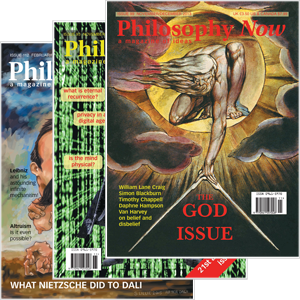
Your complimentary articles
You’ve read one of your four complimentary articles for this month.
You can read four articles free per month. To have complete access to the thousands of philosophy articles on this site, please
Sources of Knowledge
The Philosophical Method of Exception
Peter Keeble spotlights and critiques a common philosophical technique.
One of the ways philosophy works is this. You define some useful concept, such as knowledge, or morality, or inductive reasoning. Then someone comes along with an example of knowledge, or a moral act, or a property concerning inductive prediction that seems to lie beyond those defining characteristics. This happened not so long ago in all these cases. Knowledge was well established as ‘justified true belief’ until Edmund Gettier’s brief 1963 article ‘Is Justified True Belief Knowledge?’ gave apparent counter-examples. Immoral acts, we would always have previously assumed, must involve some harm to someone – until Derek Parfit’s Reasons and Persons in 1984. Inductive reasoning, though always held in suspicion by philosophers, became doubly so with Nelson Goodman’s Fact, Fiction and Forecast (1955). We want to be sure about what constitutes knowledge, morality, and inductive reasoning, since we use these concepts every day. We think we understand them, but , do we really?
Gettier on Knowledge
Here’s one of Gettier’s counter-examples to knowledge being justified true belief. Smith and his friend Jones apply for a job. At his interview, the CEO strongly suggests to Smith that Jones will be the successful candidate. For some bizarre reason, while Jones is interviewed, Smith counts the coins in his friend’s pocket: there are ten. Smith therefore feels he knows that the successful candidate will have ten coins in his pocket. But it turns out he, not his friend, gets the job. And it just so happens that he also has ten coins in his pocket. It seems therefore that he had a justified true belief that the successful candidate would have ten coins in his pocket. Yet we do not feel it right to say he knew this.
What about this case would enable us to say Smith did not have knowledge? Perhaps it’s that what Smith actually believes is that the successful applicant has ten coins and that it’s someone other than himself. Perhaps Gettier has confused the issue by not stating both these beliefs in full. Moreover, Smith’s curiosity is limited. Many people may carry around ten coins. Had he dug deeper into his friend’s pockets he might have found a £100 note. If Smith did not have such a note, wouldn’t he have been more justified in saying that the successful candidate would have such a high value note? There are degrees of justifiability and they are related to the degree of specificity.
Regardless of what we might say here, many think this is a genuine counter-example to the claim that knowledge is justified true belief.
Parfit on Immorality
It has traditionally been assumed that an act can be immoral only if it harms someone. Against this, in Reasons and Persons, Derek Parfit posits the example of a fourteen-year-old girl deciding to have a baby. Now, we imagine that the baby will have a life worth living; but it will not be nearly as good a life as that for some other baby the girl might have ten years later instead of this one. But who has the fourteen-year-old pregnant girl actually harmed if she goes ahead with the pregnancy at fourteen?
This is the ‘Non-Identity Problem’. It arises because the child born to the fourteen-year-old mother cannot, as it were, hang around in limbo waiting to be born ten years later: that would be a different child. So, although by having the baby at fourteen the girl has opted for a less happy child than had she waited ten years, that child is in no way harmed, because that child has no option of waiting for a more satisfactory or happier life in the future: that child cannot be born later. Indeed, if we’re looking at harm, we might say the possible child to be born ten years hence has been harmed because they will no longer be born. But even that problem can be resolved if the girl later has the other child too.
This is another maddening counter-example: What most of us regard as in some sense immoral – deciding to have a baby at fourteen in the knowledge that a child with a better life could be born ten years later – appears not to harm anyone. How can this be?
Clearly the issue revolves around the fact that the timing of the conception results in a unique individual whose only opportunity for existence is this specific pregnancy. Any such child would not think the mother should have waited to have some other child. But this seems a genuine problem for the idea that immorality must involve harm to someone. Perhaps it means we must adjust some small part of our notion of ethics.
Goodman on Induction
Inductive reasoning goes from observed instances to general rules. For instance, the sun has risen every morning for the past several billion years, so it will rise tomorrow. However, the justification of inductive reasoning has long been bedeviled with accusations of circularity. You cannot call upon the fact that induction has seemed to work well in the past and so is likely to do so in the future, because that reasoning is relying on a description of inductive reasoning itself, thus presupposing the very mode of reasoning we are trying to justify.
In 1955, in Fact, Fiction and Forecast, Nelson Goodman came up with a new argument claiming to show that we cannot logically rely on inductive reasoning. Suppose we have an emerald before us. It’s green, and as with all other emeralds in the past, we expect it to stay green. However, what if this emerald is in fact ‘grue’ – meaning that its colour will suddenly change to blue at a specific date in the distant future? That is fully consistent with its being green up until then. Indeed, are there not an infinity of such possible adjectives that state how things may behave differently in a different time or place for no obvious reason? Grue is just one such property; but all our observations thus far are consistent with the notion that emeralds are grue, not green.
So how do we know that emeralds are green rather than grue? The available evidence seems to support both possibilities equally well. But the ‘grue’ possibility seems to be an exception to any rules of induction we might have, by describing a property that comes and goes with no rhyme or reason.

Not blue yet
Emerald by Didier Descouens 2009 Creative Commons 3.0
This strikes me as an unnecessary complication of the problem of induction. What is added by this new term describing a property that no one’s ever observed, over and above simply asserting the possibility that previously well-behaved objects may behave in unpredictable ways at some stage in the future? Our language has developed to reflect our experience of a rule-based universe, so why invent terms to describe the unexplained breaking of those rules at some unspecified point? Especially when we have the issue of induction we’re already gnawing away at: how can we be logically justified in saying that the past is a good indicator of what will happen in the future?
Moreover, in the case of emeralds, we base our implicit prediction of their stability on more than simple induction. It’s based on the idea that causality works through various known regularities, and these don’t include anything that would suddenly make emeralds turn blue. Certainly, some difficult-to-observe mechanism may be hidden from us because of the limitations of our knowledge and equipment. Certainly there may be miracles in which the normal laws of causality are suspended. But within our current understanding of causality there is no reason to think that emeralds are likely to ever spontaneously change colour.
The Nature of Definition
Each of the above examples appears to show there is something wrong with the descriptions or defining characteristics of our most basic understandings of knowledge, of morality, and of induction, respectively, by highlighting apparent anomalies or exceptions. But I’m beginning to think that there is a problem with this widely-used approach in philosophy; or at any rate, with these three cases. Most of us will think that in the great majority of cases, what we regard as knowledge will be justified true belief; that immoral acts must involve harm to someone; and that there must be some rational basis to induction. These rather convoluted counter-examples should not let us forget such basic understandings. But they do nonetheless appear to be counter-examples. So perhaps the problem lies with our expectation that our definitions and understandings of all phenomena should and could always be water-tight.
One useful way to generate a definition is by using Aristotle’s per genus et differentiam (‘through class and difference’): you take the idea to be defined, and say, first, what sort of thing is it, and second, how it differs from others of that kind. This often works well:
a. What is a sock? An article of clothing (class) worn on the foot (difference).
b. What is jewelry? Ornamental pieces worn for personal adornment.
c. What is a physical object? An entity that is extended in space (unlike fictional objects for example, such as Sherlock Holmes).
However, there are problems even with these definitions. Is not a stocking also an item of clothing worn on the foot? Does jewelry include watches, which for some of us have more a utilitarian than an ornamental function? Are shadows physical objects? They seemingly take up space, but can hardly be said to have physical substance. Are they really extended in space, even?
It appears that we have to accept that our definitions, or our common understandings, are using the imperfect tool of human language. Language is a technology that in broad purposes suits us well, but which may lead us into vagueness, contradiction, or silly inventiveness. And if we can readily accept this in the cases of socks and jewelry, then why not in the cases of knowledge, morality, and induction? Indeed, why should we even expect so evolved a tool as language to match up perfectly with our psychologically-infused notions of what we think we know, how we should act, and what we can predict?
Does this mean that Gettier, Parfit, and Goodman were unwittingly as much participants in a Wittgensteinian exposé of the limitations of language as they were in searches for the true natures of knowledge, morality, and induction? Alternatively, are we really missing something major in our understanding of these concepts just because our language does not readily snuff out a few counter-examples?
Also, of course, we might question whether these are in fact counter-examples. Isn’t widening the description of ‘the successful job candidate’ to incorporate an irrelevant matter of coins in the pocket, somehow illegitimate? Does looking at the benefits of birth to an older mother from the point of view of an imaginary child who snaps out of existence when the mother decides to have a child ten years earlier, really impact our understanding of morality? Does the invention of strange and erratic properties that go against all our understanding really sound the death knell of induction? Indeed, perhaps these counter-examples are describing different phenomena to knowledge, morality, and induction. Why should we not limit those terms to the large majority of cases, where they clearly fit well, and relegate the supposed counterexamples to the set of interesting but exotic phenomena lying beyond the classes of phenomena being considered?
© Peter Keeble 2025
Peter Keeble is a poet, and a retired teacher and local government research officer who lives in Harrow.









